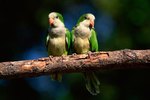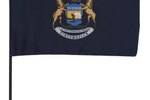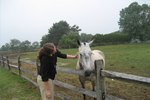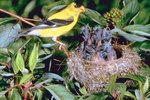
Birds are banded for various reasons. Carrier pigeons are banded by pigeon fanciers for identification purposes. Pet bird hobbyists and breeders use leg bands to identify the origin of each bird born domestically, while imported birds are banded to identify the importer and facility. Researchers, conservationists and zoos band birds with wing or leg bands. Band colors, markings and sometimes even the leg chosen for banding hold meaning for data collection and identification.
Carrier Pigeons
Pigeon post, the practice of using carrier pigeons to carry messages and small packages from one location to another, began more than 5,000 years ago. Carrier pigeons, aka homing pigeons, are descendants of domesticated rock pigeons from North Africa, Asia and Europe. They served until the 19th century and the invention of the telegraph to relay military information between posts, and to deliver news and financial information. Pigeon fanciers continue to raise and race carrier pigeons today, and use leg bands to identify the birds. These registered bands have series of numbers and letters to identify the club that issued the band as well as the year the bird was hatched and banded. In addition to facilitating identification and registration of birds for racing and breeding purposes, banding makes it easier to reunite lost birds with owners.
Pet Birds
Bird clubs, organizations and societies for pet bird hobbyists and breeders, such as the Society of Parrot Breeders and Exhibitors, use leg bands to identify the origin of each bird born domestically. Imported birds are banded to identify the importer and facility through which the bird was imported. Wild-caught Psittiscine birds -- parrots -- were legally imported until 1992, when the U.S. Fish and Wildlife Service enacted the Wild Bird Conservation Act. Legally imported birds wear specially marked bands that indicate where they were quarantined. A parrot with a leg band beginning with the letter F, C, O, M, I, L or N, followed by two more letters and then three numbers, could have been caught wild outside the United States and imported legally before 1992.
Bird Banding Program
The North American Bird Banding program is administered by the U.S. Geological Survey in conjunction with the Canadian Wildlife Service. The USGS Bird Branding Laboratory's program uses uniquely numbered leg bands to identify each bird’s age, gender and more; a record of each band is stored at the Patuxent Research Center in Maryland. When a banded bird is found the information from its leg band is reported to the Bird Landing Laboratory, where the data for species movement and distribution, numbers, life span and causes of death are compiled.
Banding Data Tool
The first birds banded in North America, reports Flyways.us, a collaborative effort of North American waterfowl managers, took place through the Smithsonian Institution in 1902 when 23 black-crowned night herons were banded in the Washington, D.C., area. The practice quickly took hold and, since 1914, banding and recovery records of migratory birds have been maintained, with data going back to 1914 available through the USGS website.
Research Projects
In addition the federally issued aluminum bands etched with identifying numbers as required by the USGS Bird Branding Laboratory, some conservationists and scientists band birds with additional plastic or metal leg or wing bands. These additional bands identify birds being followed for specific research projects and are particularly helpful in studies of bird species too small for radio collars or GPS tracking tags. Individual birds may have as many as two bands on each leg; the combination of colors making them easily identifiable by sight, even from a distance.
References
- American Racing Pigeon Union: Understanding How to Read a Pigeon Band
- American Racing Pigeon Union: The Origin and History of American Racing Pigeon Union
- U.S. Fish and Wildlife Service: What Is the Bird Banding Program?
- Flyways.us: Bands Across North America
- U.S. Fish and Wildlife Service: Patuxent Research Center
- Sandiego Zoo: Bling with a Purpose
- The Cornell Lab of Ornithology: Frequently Asked Questions
- National Band and Tag Co: Bird Bands
- USGS: Report of the Federal Advisory Committee on the Bird Banding Laboratory
- USDA Animal and Plant Health Inspection Service: Animal and Animal Product Import: Bird Leg Band Information
Resources
Photo Credits
-
Joe Raedle/Getty Images News/Getty Images
Writer Bio
Christy Ayala writes about recreation, sports, aquatics, healthy living, family and parenting, language development, organizational change, pets and animals. Ayala holds a master's degree in recreation administration from Aurora University’s George Williams College, a graduate certificate in organizational change from Hawaii Pacific University and a bachelor's degree in Spanish from the University of Missouri, St. Louis.




